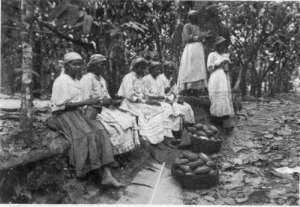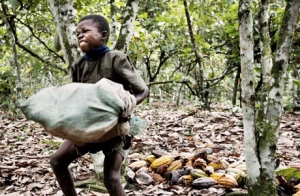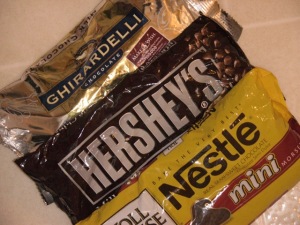









In the strange, occult worlds of pharmacopeia, few drugs have escaped the repressive clutches of European sadists and madmen.
The reasons for non-prohibition often refer to a particular exotic drug’s negligible effects on the mind. If the drug causes havoc with the sinful body, and yet does not induce much of a mental change, then the elixir transforms into a good and marketable digestible. Such is the modern story of Chocolate, or as the Mexica-Aztecs referred to it, in their language of Nahuatl, Xocolatl.
The 1430s AD was a consequential decade for human civilization. In China, the Han Chinese, Ming Dynasty established a naval fleet in order to extend the economic influence of the Empire. Yet during the same period, agricultural disasters, famine and pestilence hit the Chinese rural valleys, and so the naval empire had to end. In Indochina, the Empire Ayutthaya, (modern Thailand or Siam), conquered the great empire of the Khmer at Angkor Wat (modern Cambodia).
In Europe, the religious wars and Crusades of the Catholic Papacy and Orthodox Christianity continued. First, they fought against the Muslim Turks, who surrounded the Second Rome, Constantinople, on both flanks, Asia Minor and Greece. The Teutonic knights maintained their violent forays into the northeast, against both Poland and Lithuania. The Catholic Holy Roman Emperor eventually defeated the Protestant Hussites, (influenced through Jan Hus), in the Czech lands.
In the southwest, the Spanish knights advanced their attacks against the Moors, or Muslims, in the region of Nasrid Granada. The Church continued its noxious insistence on the conversion of Europe’s Jews, whether through persuasion, legal harassment, or even the sword.
The French Royal forces began to push out the English Plantagenet royal armies from French territory, and a German, by the name of Johannes Gutenberg, developed the first printing press.
Italian artists finally moved away from the medieval, Byzantine-influenced figure painting of long faces and wide eyes, to more realistic portraits, using the ocular mirror-reflection method. The Venetian Empire possessed the most powerful naval army, and the most heinous slave trading, mass murder, sugar plantation system in the Mediterranean.
With the Pope’s mandate for the Christianization and enslavement of the pagans, the Portuguese Empire traded for gold in west Africa, and especially with the Mali Empire in Timbuktu. Due to this trade, this same Empire would later claim slave prisons and colonies on the western coast of sub-Saharan Africa, in a region referred to as Guinea. The Portuguese colonial navy initiated European Civilization’s most heinous mass murder scheme in human history: the Atlantic African Slave Trade. Europe’s invaders had yet to conquer the Western Hemisphere.
This decade also featured the political-military consolidation of the Mexica-Aztec Empire. The emperor, or Tlatloani, had the name of Izcoatl. Izcoatl was a great warrior and political leader who merged the military Triple Alliance of the three most powerful cities: Tenochtitlan, Texcoco and Tlacopan, in central Mexico.
He also oversaw the construction of the great buildings inside the grand city of Tenochtitlan. The two pyramid apexes represented: the God of Agriculture and Water, Tlaloc, and the greater structure, the God of the Mexica: war, blood and fire, Huitzilopochtli.
His successors would continue conquer lands for imperial tribute – until the unfortunate death of Moctezuma II, during the Spanish invasion of the 1520s. One of the coveted lands for tribute, or for taxes, were the southern Mayan farms of cacao beans. When grounded, those cacao beans transformed into a dark and powerful, yet delicious, bitter drink, called Xocolatl.
Towards the end of his glorious reign, Izcoatl ordered the priests to consecrate the temples for the grand sacrifices and coming religious festivals. The emperor and the noblemen drank Xocolatl in the courts of the palace. They sipped Xocolatl cold with ice, inside of large, dark red ceramic bowls. The cooks mixed in cornmeal to make the froth thicker. The royal preparers also added honey to soften the bitter taste, and then the local spices of red chilies, annatto red color, and canella cinnamon, all of which gave the icy Xocolatl the appearance of human blood.
The Aztec priests had their long black hair drenched in red blood dye. The Jaguar skinned and Eagle feathered knights were in attendance, and they were all in the presence of the feathered serpent-god, Izcoatl-Quetzalcoatl emperor.
All of them gulped the blood-colored, darkened froth, which transformed the participants into a mental state of rapture. They sat around a large and low stone table, and continued to taste the bowls of delight, meanwhile royal musicians played military drums and flutes, and the priests burned pungent copal incense. All of the six human senses flourished under this military reign.
Emperor Xocolatl’s body was the blood and oil to the mental states of war bounty, the delight of death, and sacrificial festivities.
Through these intense royal Mexica rituals, Moctezuma I, the successor of Izcoatl, initiated the Flower Wars. Aztec knights engaged in noble combat-contests with their enemies, such as the Tlaxcaltecans, in order to increase their military courage and fighting abilities. The great market of Tenochtitlan even used cacao beans as currency. Xocolatl had finally united, both in body and spirit, or tonalli, with the drink of the Gods.
Xocolatl, or its Latin name, Theobroma Cacao, like other Western Hemisphere wonders, such as tomatoes, corn maize, squashes-zucchinis-pumpkins, potatoes, red-green chili peppers-paprika, coca, tobacco, avocados, annatto, amaranth, peanuts-cashews-pecans-sunflower seeds, papaya-guava-pineapple, wild berries, common bean legumes, and vanilla, would permanently transform European cuisine – and even world gastronomy.
These Western Hemisphere native, garden delights now find themselves at every world table: the Americas, Europe, Africa, Asia and Oceania. European colonialism has transformed Chocolate Cacao once again, and it has cut off its sacred origins from Mesoamerica.
The first methods represented the African killing centers or the Americas, or within its infamous slave plantations. Chocolate plantings coincided with tobacco, sugar and coffee crops, all of which functioned as export commodities on the Atlantic slave trade.
European investors would later add industrial concoctions into the chocolate mix, which gave the drug – from the once extinct Mesoamerican gods – a new identity. European food capitalists introduced the dark-thick cacao to ravenous sugar, silky cow’s milk, and the sweet tooth decadence of fruits and nuts.
Chocolate is not just a drink anymore; instead, consumers can purchase the drug in cakes, cookies, candies, bars, creamy spreads, chips, white and cream colors, powders while cooks have added it to fine dishes, such as the Mexican recipe of mole.
Chocolate has entered the fine drug Valhalla of vintage wines, sweet liqueurs, pungent tobacco cigars and expensive bottled spirits. This drug is also ubiquitous inside many processed GMO, sugary snacks, which destroy the fragile human body. For those gourmets of gluttony, the physical price leads to obesity and diabetes.
During the decade of the 1580s, in the Hispano-American lands, Spanish ecclesiastics and other elites began to partake in the leisurely enjoyment of the drink. In the seventeenth-century, the 1600s, Mercantile Capitalism exploded chocolate into the refined tastes and idle pleasures of European aristo parasites, representing the first two social estates, or classes, the nobles and the clergy.
Coffeehouses in London started to serve the hot chocolate brews, and in Paris, the first artisan workshops of chocolate emerged, calling themselves, chocolatiers. Those chocolate artisans sold a most expensive delight, called bons bons.
On the American continent, every single Euro-American colonial power: the Spanish, Portuguese, Dutch, French and English ensured that their sugar, salt, coffee and tobacco slave plantations, had to leave a few grounds for the cultivation of chocolate beans. The European colonial monsters gave the African slaves more work to perform before their short, brutal lives, and even more cruel deaths.
Like Sugar and Coffee export commodities, Chocolate production also violated the horrible existences of kidnapped African chattel. The European aristo rage for hot chocolate, or hot cocoa, and exquisite chocolate candies, called pastilles, would not subside.
In the eighteenth-century, the 1700s, Europeans became so enamored with chocolate that inventors developed mechanisms in quickening the pulverization of beans into cocoa powder. The French and the English became quite adept at this grinding process. Thanks to the such technology, the European working classes began to partake in the ‘drink of the Gods.’
It was during the 1800s, in Europe and the Americas, and especially in Switzerland, where chocolate factories invented industrial schemes that transformed chocolate to the consumer product of today.
First, they used machines to remove the chocolate butter from both the beans and powder during the grinding down process. Second, the factories added sugars, fatty nuts, and whole white milk into the mix, all of which created a finer, creamier and more delicious chocolate, free from its bitter origins. Third, they created assembly lines that formed the butter, powder, sugar, nuts and milk into bite sized candies, called pralines.
Some of the more notable names of the European-American Chocolate capitalists included: Stollwerck, Berwaerts, Cadbury, Ghiradelli, Lindt, Tobler, Hershey and Nestle. All social classes enjoyed the chewing, eating and drinking of chocolate.
Nowadays, most of the worlds’ chocolate bean production occurs in west Africa. Apparently, the chocolate capitalists still treat and pay their workers like slaves.
Chocolate still lives among our innumerable products on the supermarket shelves, yet massive food corporations combine it with high amounts of sugar, and then mix it all with horrid GMOs, or genetically modified products. All of those carcinogens destroy the delicate human body. Chocolate is still delicious, yet it eventually leads to gluttony, fast weight gain, and if abused, obesity.
Chocolate was once the food of the gods – found in the secret halls of Mayan and Aztec royalty. Later in history, European colonials invaded the Americas, destroyed their grand cultures, and stole their wondrous products.
European mercantile capitalism then murdered millions of Africans in order to process American plants, inclusive of the other European addictions, such as sugar cane, coffee beans and tobacco leaves. Ultimately, European technology transformed Chocolate through the processes of industrial capitalism, so that it is extremely rich and tasty. This process will also destroy the tenuous human body.
In fin, the Chocolate drug, with its sordid history, exposes Modern European Civilization’s profound culture of avarice, luxury and gluttony.